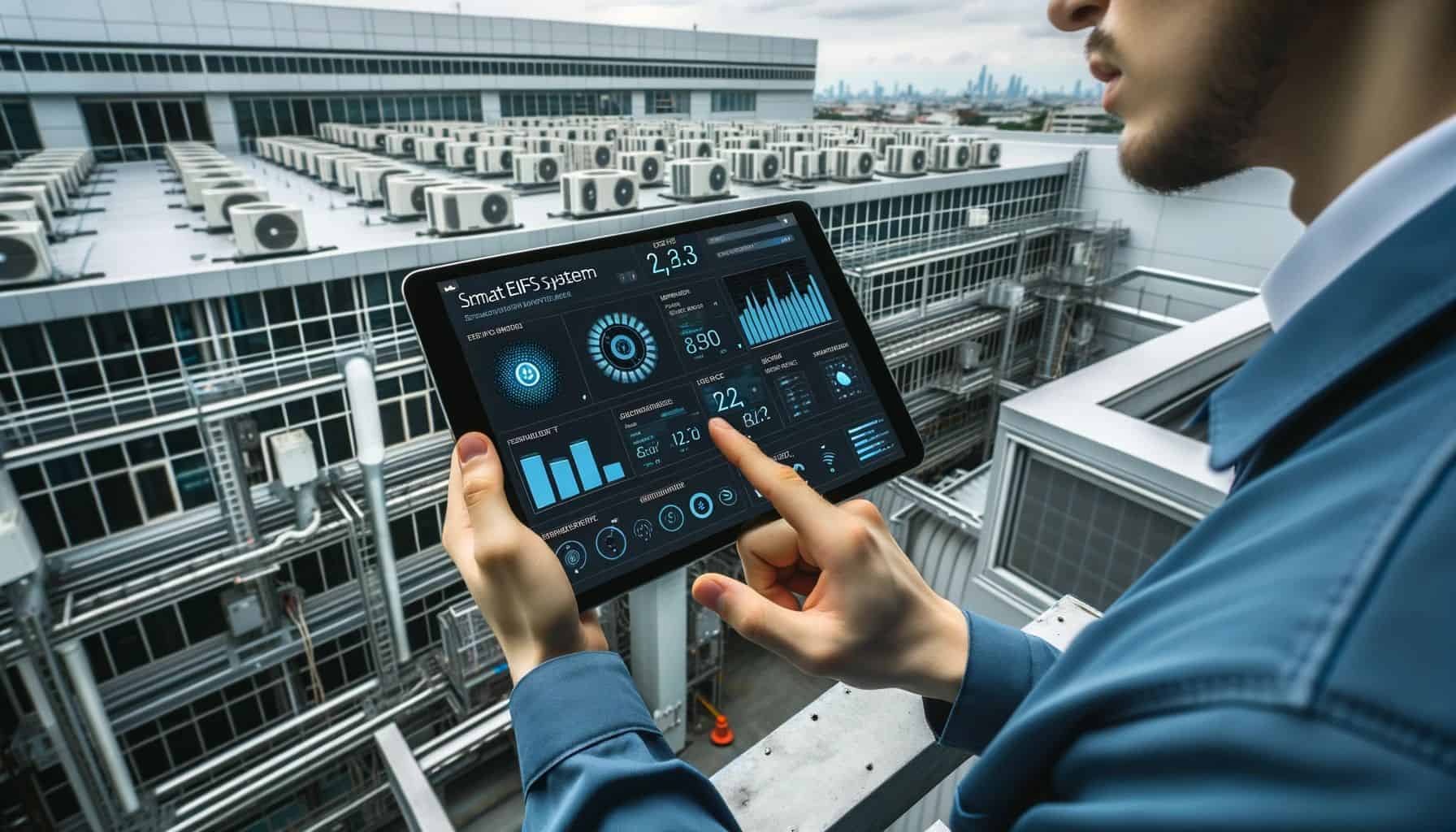How 3D Printing and Robotics Are Revolutionizing EIFS Installation Across Central Indiana
The construction industry stands on the brink of a digital revolution. 3D printing and robotics are transforming how we think about EIFS installation. These technologies promise faster construction timelines, reduced labor costs, and unprecedented design freedom.
After 22 years in the EIFS business, I’ve seen plenty of changes. But nothing compares to what’s happening right now with automated construction methods. At Indiana Wall Systems, we’re closely watching these developments. They’re going to change everything about exterior wall systems.
Key Takeaways
- 3D printed EIFS panels can reduce installation time by up to 60% compared to traditional methods
- Robotic applicators ensure consistent thickness and eliminate human error in basecoat application
- Digital fabrication enables complex architectural designs previously impossible with conventional techniques
- Prefabricated building envelope systems slash on-site waste by 40-70%
- Smart materials integration creates self-monitoring EIFS systems with predictive maintenance capabilities
The Current State of EIFS Technology
Traditional EIFS installation involves multiple manual steps. Each layer requires skilled craftsmen. The process is labor-intensive and weather-dependent.
Current EIFS systems like Sto Therm CI and Dryvit Outsulation rely on field application. Workers apply basecoat, embed glass-fiber mesh, and finish with high-build finish coat. While effective, this method has limitations.
Construction timelines often stretch due to weather delays. Labor shortage in skilled trades creates bottlenecks. Material waste on job sites can reach 15-20%.
These challenges drive the push toward construction automation. The future of EIFS lies in solving these problems through technology.
- ⚠️ Labor-intensive manual steps
- 🌧️ Weather-dependent timelines
- 👷♂️ Skilled craftsman shortage
- 📈 15-20% material waste
- ⏰ Extended project delays
- 💰 Rising labor costs
- 🤖 Automated robotic application
- 🏭 Climate-controlled fabrication
- 🎯 AI-powered precision systems
- ♻️ 75% waste reduction
- ⚡ 60% faster completion
- 💡 Mass customization capability
Revolutionary 3D Printing Technology in EIFS
3D printing technology is reshaping exterior wall construction. Companies like Branch Technology are pioneering large-scale additive manufacturing for building components. Their cellular fabrication process creates complex geometries impossible with traditional methods.
3D printed EIFS panels start with digital design. Architects use Computer-Aided Design (CAD) and Building Information Modeling (BIM) for parametric façade optimization. Generative design software powered by Artificial Intelligence (AI) enables mass customization while maintaining cost efficiency.
The 3D printing process begins with a gantry-mounted printer. A concrete extruder arm deposits smart concrete or bio-based polymers layer by layer. Lightweight composite panels emerge with integrated drainage planes and continuous insulation layers featuring aerogel insulation or vacuum insulated panels.
Key Advantages of 3D Printed EIFS
Design freedom tops the list of benefits. Complex architectural designs become feasible without custom molds or forms. Parametric design allows architects to optimize every element.
Material efficiency improves dramatically. 3D printing uses only the material needed. Waste drops from 15-20% to under 5%. Embodied-carbon savings reduce environmental impact.
Construction timelines shrink significantly. Prefabricated panels arrive on-site ready for installation. Weather delays become less critical. Just-in-time delivery reduces storage needs.
Quality control reaches new levels. Computer-vision quality control powered by Machine Learning monitors every layer. Digital Twin Technology creates virtual replicas ensuring consistency across panels. Laser-scanning verification confirms dimensional accuracy while Augmented Reality (AR) assists installers with real-time guidance.
Robotic EIFS Installation Systems
Construction robotics addresses the skilled labor shortage. Robotic applicators ensure consistent material application. Collaborative robots (cobots) work alongside human installers.
Robotic plastering systems apply basecoat with millimeter precision. Trowel-robot accuracy eliminates thickness variations. Automated material handling reduces physical strain on workers.
Components of Robotic EIFS Systems
Safety-by-design robots prioritize worker protection. Robotic exoskeleton support assists human operators. Construction drone mapping provides real-time progress monitoring while Virtual Reality (VR) training prepares workers for robotic interaction.
Material-extrusion printing creates continuous application. Geopolymer concrete mix flows smoothly through robotic systems. Polymer-modified basecoat maintains workability longer.
CNC hot-wire cutting shapes EPS foam cores precisely. Carbon-fiber reinforcement and graphene-enhanced materials integrate during automated layup. Advanced composite mesh bonds perfectly with robot-applied self-assembling materials that optimize their own structure.
Smart Materials and IoT Integration
The future of EIFS includes smart materials. Phase-change materials regulate interior temperatures automatically. Internet of Things (IoT) sensors enable IoT-enabled envelope monitoring that tracks performance in real-time across the Indianapolis metropolitan area.
Smart envelope sensors measure thermal conductivity and vapor permeability continuously. Predictive maintenance data prevents problems before they start. Building automation systems optimize energy performance while monitoring freeze-thaw durability and UV resistance in Central Indiana’s challenging climate.
Dynamic thermal performance adapts to conditions automatically. Vapor-permeable membranes respond to humidity changes while maintaining optimal impact resistance. Hygrothermal performance improves through intelligent materials that self-regulate based on Midwest construction market conditions.
Energy Efficiency Breakthroughs
R-value optimization reaches new heights with smart systems. Thermal-bridge reduction becomes more effective. Air-infiltration control improves dramatically.
Net-zero-ready envelope systems integrate seamlessly with renewable energy. LEED v4.1 credits become easier to achieve through automated quality. International Code Council (ICC) guidelines drive compliance standards.
ASHRAE 90.1 envelope requirements are exceeded regularly through lean construction methods. ASTM International testing protocols like ASTM E2568 validate performance claims. National Institute of Standards and Technology (NIST) research guides development standards.
Leading EIFS Manufacturers Embracing Technology
Sto Corp leads innovation in digital fabrication and offsite construction. Their Sto Panel Technology incorporates 3D printable components using just-in-time manufacturing principles. Prefabricated wall panels arrive with integrated air and moisture barriers optimized for volumetric construction methods.
Dryvit develops robotic-compatible formulations using hybrid construction methods. Their systems work seamlessly with automated applicators while maintaining superior fire spread index ratings. Senergy EIFS products adapt to construction robotics software following EIMA (EIFS Industry Members Association) guidelines.
Parex Alphalinc focuses on smart building integration. BASF Masteremaco creates molds for 3D printed applications. TeIFS Weathertight systems embrace modular construction workflows.
Real-World Applications and Case Studies
Residential construction benefits immediately from these technologies. 3D printed houses in Europe showcase possibilities. Affordable housing projects use automated construction to reduce costs.
The largest 3D printed buildings demonstrate scale potential. Conventional construction methods can’t match the speed. Construction timelines shrink from months to weeks.
Commercial construction adopts robotic systems faster. Office complexes use prefabricated building envelope systems. Hotel restoration projects benefit from digital fabrication workflows.
Cost Analysis: Traditional vs. Automated EIFS
| Factor | Traditional EIFS | Automated EIFS | Savings |
|---|---|---|---|
| Labor Hours per 1000 sq ft | 120-150 hours | 40-60 hours | 60-75% |
| Material Waste | 15-20% | 3-5% | 75% reduction |
| Construction Timeline | 8-12 weeks | 3-5 weeks | 60% faster |
| Quality Variations | ±10% thickness | ±2% thickness | 80% improvement |
| Weather Delays | 15-25 days | 3-5 days | 80% reduction |
Cost-per-square-foot savings range from 20-40%. Labor-shortage mitigation provides additional value. Accelerated construction schedules reduce financing costs.
Environmental Impact and Sustainability
Embodied-carbon savings reach 30-50% with 3D printing. Circular-economy materials integrate easily. Recycled EPS content increases in automated systems.
Waste-diversion credits come naturally with digital fabrication. Life-cycle assessment shows clear benefits. Cradle-to-cradle certified materials work well with robots.
Low-embodied-energy materials reduce carbon footprints. Construction drone inspection minimizes travel emissions. Site-logistics efficiency cuts transportation needs.
Challenges and Limitations
Initial investment costs remain high for robotic systems. Construction professionals need new training. Building codes lag behind technological capabilities.
3D printing companies face scaling challenges. Range of materials stays limited currently. Structural integrity requires careful validation.
Weather sensitivity affects some 3D printing processes. Quality assurance protocols need development. Insurance coverage for new methods creates uncertainty.
Future Outlook: What’s Coming Next
Pilot Projects
Testing
Deployment
Adoption
Standard
Autonomous material handling will advance rapidly. Drone façade inspection becomes standard practice. Thermographic imaging scans integrate with AI analysis.
Construction robotics will become smaller and more agile. On-site 3D printer deployment increases mobility. Collaborative robots work more seamlessly with humans.
Smart materials will include self-healing properties. UV-stable finish coats last longer. Elastomeric topcoats adapt to building movement automatically.
Regional Considerations for Central Indiana
Indiana building codes welcome innovation carefully following ICC standards. Our climate demands crack-resistant layers with superior freeze-thaw durability. Hurricane-zone compliance doesn’t apply here, but seismic-tested panels provide peace of mind for Hamilton County and Marion County projects.
Construction companies in Carmel, Fishers, and Zionsville show growing interest. Homebuilders ask about automated options regularly.
Local labor markets benefit from construction automation. Skilled trades evolve rather than disappear. Workers learn to operate robotic systems instead of just hand tools.
Implementation Strategies for Contractors
Digital supply-chain traceability becomes essential for lean construction. BIM integration drives project success through Digital Twin Technology. Commissioning process checklists must include new technologies while ensuring UV resistance and impact resistance standards.
Training programs need immediate development. Safety protocols require updates for robotic operations. Quality assurance plans must cover automated processes.
Façade engineering services become more important. Envelope performance upgrades justify technology investments. Life-safety code adherence remains paramount.
Potential Savings with Automation
How Indiana Wall Systems Prepares for the Future
We’re investing in digital fabrication education. Our team studies construction robotics applications. We maintain relationships with leading EIFS manufacturers embracing innovation.
Computer-vision quality control interests us greatly. Predictive maintenance capabilities could revolutionize service. Smart envelope sensors offer new revenue opportunities.
We’re evaluating 3D printing partnerships. Robotic applicator testing begins soon. Our expertise in EIFS installation positions us well for technological integration.
Client Benefits: What This Means for You
Faster project completion reduces inconvenience. Consistent quality eliminates surprises. Lower costs stretch budgets further.
Design possibilities expand dramatically. Energy efficiency improves automatically. Maintenance requirements decrease significantly.
Property values benefit from cutting-edge systems. Insurance premiums may decrease with improved quality. Environmental impact shrinks substantially.
Integration with Existing EIFS Systems
Retrofit applications work well with new technologies. Adaptive reuse construction benefits from digital fabrication. Façade modernization projects embrace automated methods.
Traditional EIFS repair knowledge remains valuable. Hybrid approaches combine old and new methods. Substrate preparation principles don’t change.

Moisture-management strategies stay critical. Thermal performance requirements remain constant. Building envelope fundamentals guide all innovations.
Training and Workforce Development
Construction professionals need comprehensive retraining. Robotic operation requires new skills. Digital design capabilities become essential.
Safety training must cover human-robot interaction. Quality control methods adapt to automated systems. Troubleshooting skills expand beyond traditional methods.
Continuing education becomes more critical. Industry certifications will include technology components. Apprenticeship programs must evolve quickly.
Quality Control in Automated Systems
Computer-vision systems powered by AI monitor application continuously. Laser-scanning verification confirms dimensional accuracy while Machine Learning algorithms optimize thermal conductivity. Thermographic imaging detects thermal bridges instantly using Digital Twin Technology.
Statistical process control replaces visual inspection. Digital documentation tracks every parameter. Automated reporting speeds up quality reviews.
Predictive analytics identify potential issues early. Machine learning improves processes continuously. Real-time feedback enables instant corrections.
Economic Impact on the Construction Industry
Labor productivity increases 300-500% with automation. Project margins improve through efficiency gains. Capital investment requirements change dramatically.
Small contractors face technology adoption challenges. Large firms gain competitive advantages initially. Technology partnerships become survival strategies.
Market consolidation may accelerate temporarily. Innovation adoption separates leaders from followers. Customer expectations shift toward automated quality.
Regulatory and Code Considerations
Building officials need education about hybrid construction methods and offsite construction. Code updates lag behind technological capabilities from NIST research. Engineering approval processes must adapt to volumetric construction and just-in-time manufacturing.
Fire-resistance ratings require validation with graphene-enhanced materials and bio-based polymers. NFPA 285 compliance testing needs expansion for smart concrete and self-assembling materials. Fire spread index testing protocols must cover aerogel insulation and vacuum insulated panels.
Insurance underwriting struggles with new technologies. Liability assignment becomes more complex. Warranty coverage needs clarification.
Maintenance and Service Implications
Predictive maintenance powered by IoT sensors replaces reactive approaches. Internet of Things (IoT) monitors vapor permeability and thermal conductivity continuously. Machine Learning algorithms optimize service schedules based on freeze-thaw durability patterns.
Service technician training requires technology focus. Diagnostic tools become more sophisticated. Remote monitoring reduces site visits.
Spare parts inventory shifts toward electronic components. Service contracts include data management. Performance guarantees become more precise.
Material Science Breakthroughs
Self-healing materials repair minor damage automatically using smart concrete technology. Phase-change insulation regulates temperatures actively while maintaining impact resistance. Smart coatings with superior UV resistance respond to environmental conditions in the Central Indiana climate.
Nanotechnology enhances thermal conductivity and vapor permeability properties. Bio-based polymers reduce environmental impact while maintaining freeze-thaw durability. Recycled content increases without performance loss in Central Indiana’s demanding climate.
Multi-functional materials combine impact resistance, UV resistance, and fire spread index optimization. Adaptive systems change thermal conductivity characteristics as needed. Responsive materials using IoT technology optimize vapor permeability continuously.
Global Technology Transfer
European innovations lead in offsite construction and volumetric construction applications. Asian manufacturing drives cost reductions in aerogel insulation and graphene-enhanced materials. North American adoption focuses on practical hybrid construction methods for the Midwest construction market.
Technology transfer accelerates through BIM integration partnerships. International standards from ASTM International and ICC guide development. Global supply chains enable rapid scaling of just-in-time manufacturing for smart concrete and bio-based polymers.
Cultural differences affect adoption rates. Regulatory environments vary significantly. Market conditions drive different priorities.
Frequently Asked Questions
How soon will 3D printed EIFS become mainstream?
Commercial applications start within 2-3 years, with residential adoption following in 5-7 years as costs decrease and codes adapt to new technologies.
Will robots replace human EIFS installers?
Collaborative approaches using hybrid construction methods will dominate, with robots handling repetitive tasks while humans manage complex decisions, VR training, and customer relationships.
What happens to traditional EIFS repair work?
Existing buildings will need traditional repair methods for decades, while new hybrid techniques combine automated and manual approaches for optimal results.
How much do robotic EIFS systems cost?
Initial investment ranges from $200,000-$500,000 per robotic system, but labor savings and productivity gains typically justify costs within 18-24 months.
Can small contractors compete with automated systems?
Technology partnerships and equipment leasing will enable smaller firms to access automation benefits without massive capital investments in robotic equipment.
What training do workers need for robotic EIFS?
Technical skills in robotics operation, CAD and BIM literacy for system programming, and AI-powered quality control expertise for automated monitoring systems become essential.
Are 3D printed EIFS systems as durable?
Accelerated testing following ASTM International protocols shows equal or superior freeze-thaw durability, impact resistance, and UV resistance compared to traditional methods.
How do building codes address new EIFS technologies?
Code development by ICC and EIMA lags behind innovation, requiring engineered solutions and alternative compliance paths until NIST research establishes official standards.
Conclusion: Embracing the Future of EIFS
The future of EIFS is arriving faster than many expected. 3D printing and robotics will transform our industry completely. The question isn’t whether these changes will happen – it’s how quickly we adapt.
At Indiana Wall Systems, we’re preparing for this transformation. Our 22 years of experience give us the foundation to embrace new technologies. We understand that quality installation principles remain constant, even as methods evolve.
Smart building technologies powered by IoT and AI will become standard across the Indianapolis metropolitan area. Energy efficiency will improve dramatically through Digital Twin Technology. Construction costs will decrease while quality increases through lean construction methods.
The construction industry stands at a turning point driven by BIM integration and offsite construction. Early adopters of hybrid construction methods will gain significant advantages. Traditional methods won’t disappear overnight, but they’ll become less competitive in the Midwest construction market.
Property owners across Hamilton County and Marion County will benefit from faster construction, lower costs, and better performance. Design possibilities using CAD and AR will expand beyond current imagination. Sustainability goals become easier to achieve through volumetric construction and just-in-time manufacturing.
We encourage architects, contractors, and building owners throughout Central Indiana to start planning now. Technology adoption of AI, IoT, and Digital Twin Technology requires preparation and training. Competitive advantages go to those who embrace lean construction first.
Contact Indiana Wall Systems at (765) 341-6020 to discuss how these emerging technologies might benefit your next project. We’re committed to staying at the forefront of EIFS innovation while maintaining our reputation for quality workmanship.
The future of construction is digital, automated, and incredibly exciting through BIM, AI, IoT, and Machine Learning integration. We can’t wait to be part of building it with you across the Indianapolis metropolitan area.




